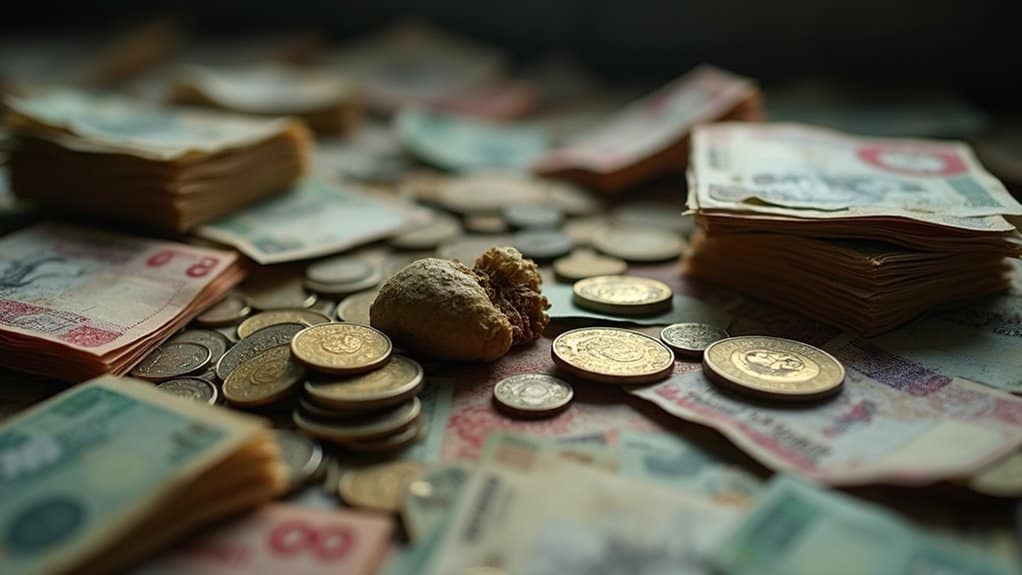The Lebanese pound anchors the list, trading near 90,000 LBP per dollar after its 2019 crisis. Iran’s rial follows, crippled by sanctions pushing inflation beyond 400%. Vietnam’s dong, Indonesia’s rupiah (~16,500 IDR/US$), and Laos’ kip also suffer drastic devaluations fueled by political instability, unreliable exports, and chronic inflation eroding daily purchasing power. You must grasp how thin central bank reserves and commodity dependence intensify volatility for these currencies. Understanding their specific pressure points reveals critical trading risks…and potential signals ahead.
Lebanese Pound (LBP)
The Lebanese pound earns its status as the world’s weakest currency, period. Your benchmark metric looks brutal: $1 buys nearly 90,000 LBP, making one pound virtually worthless.
This currency depreciation stems directly from a catastrophic banking crisis erupting in 2019, paralyzing the financial system. Years of deep political instability prevent solutions, fueling unchecked high inflation that decimates savings and wages daily.
The resulting economic downturn is significant, marked by soaring unemployment. Forget foreign investment; capital flees. Basic goods become unaffordable luxuries as the pound’s value craters further.
Tourism evaporated, stripping another crucial income stream. It’s a crippling economic death spiral few escape.
Iranian Rial (IRR)
You face Iran’s spectacularly weak rial (IRR), where harsh international sanctions utterly dominate the currency’s catastrophic fall.
This intense external pressure, starting after the 2015 nuclear deal collapsed, slashed its value to below $0.000024 per rial – that’s over $42,000 Iranian rials for just one US dollar.
Sanctions drastically limit Iran’s foreign exchange liquidity too, introducing significant friction into all international financial transactions while domestic inflation roars beyond 400%.
Sanctions’ Dominant Impact
Global sanctions crippling Iran’s economy since 2015’s nuclear deal collapse have made its currency nearly worthless; the Iranian rial, trading at a staggering 42,112.50 to every $1, anchors the bottom of global currency rankings.
Sanctions obliterate Iran’s foreign trade access, triggering hyperinflation exceeding 400% and accelerating the rial’s devaluation by throttling imports like food and medicine.
You see an economic stranglehold complexly tighten: plummeting export earnings and blocked transactions defy monetary policy fixes.
Geopolitical tensions complicate further escalation or relief—each diplomatic stalemate battering the currency anew.
Traders confront a unit so sanctions-dominated it ignores traditional indicators, moving solely on geopolitical tremors and White House press briefings.
Recovery? It’s imprisoned in sanctions dismantling, not by Tehran’s control.
Severe Currency Devaluation
Occupying history’s currency abyss, Iran’s rial officially stands as the world’s weakest, your dollar buying a staggering 42,112.50 IRR – a number that crystallizes how sanctions strangle real economic lifeblood.
This extraordinary placement confirms the Iranian rial‘s title as the uncontested weakest currency, suffering severe devaluation. Crushed under decades of economic sanctions and combustible political instability, like the fallout from Mahsa Amini’s death triggering a 29% plunge, the IRR’s value evaporated.
Its stunning fivefold drop since 2018 fuelled catastrophic hyperinflation, near 400% in 2023, annihilating citizens’ purchasing power. Forget scraping bottom; you’re losing value faster than you can count it, even if official aren’t using market rates.
Limited Forex Liquidity
Because international sanctions lock out Iran’s rial from major currency markets, liquidity for the IRR is practically a mirage.
You’ll find minimal trading volume, turning order execution into navigating a vast desert. Those severe sanctions cripple the Iranian rial’s access to global forex liquidity, trapping it within its borders.
Add stratospheric inflation rates near 400%, and you evaporate any real appetite among traders. Foreign investment stays away due to this depressed economy, further shrinking available liquidity.
Expect wildly volatile price movements and enormous spreads if you attempt trades; the market’s thinness means even small orders can cause significant ripples.
Vietnamese Dong (VND)
Ever wonder how one US dollar requires nearly twenty-six thousand Vietnamese dong? That extreme exchange rate screams weak currency. You face such low valuation exacerbated by long-standing economic restrictions and persistent inflation eating into purchasing power.
While Vietnam boasts strength in manufacturing and services, its heavy reliance on trade means rising US dollar strength, driven by Federal Reserve hikes, significantly pressures the Vietnamese dong. Consequently, the central bank strategically devalues the currency to enhance export competitiveness.
Though this reinforces its weakness, strategic location and surging tourism hint at potential resilience beneath the surface vulnerability.
Laotian Kip (LAK)
You’ll find the Laotian kip burdened by severe, persistent inflation, severely devaluing its purchasing power since its 1950s introduction.
Its weak export economy, heavily reliant on commodities like copper and gold, isn’t a powerhouse; being landlocked limits trade diversification and access.
This combination makes navigating global markets exceptionally challenging for Laos, contributing heavily to the kip’s status as one of the world’s weakest currencies.
High Inflation Rates
While aiming for economic growth, Laos faces brutal currency realities as hyperinflation mauls the Laotian Kip (LAK), slashing its purchasing power and creating significant instability.
High inflation rates, now compounded by volatile global market fluctuations, mean your basic goods cost astronomically more in kip terms.
This unrelenting currency depreciation leaves the LAK perilously low at ~21,625 per $1.
It fuels pervasive economic instability, eroding savings and stifling investment needed to counter sluggish economic growth.
Mounting foreign debt becomes far heavier to service under inflation’s weight.
For traders, this depreciation directly impacts pricing strategies and profits, demanding constant vigilance against unseen inflationary surges.
Weak Export Economy
Laos’s inflationary spiral doesn’t operate in a vacuum; exports become significantly costlier when a currency bleeds value – for the Lao PDR, its narrow export base adds fuel to the fire.
You see a weak export economy dominated by agricultural reliance (cash crops) and minerals like copper.
Problem is, it’s spectacularly narrow. Even selling hydropower to Thailand hardly saves the day.
So, when the Laotian kip plunges against the dollar, desperate imports of essentials surge, turbocharging inflation rates.
This vicious cycle highlights deep economic vulnerabilities.
You need hefty foreign aid and investment – hopefully funding vital infrastructure projects like railways – to eventually diversify exports and stabilize the kip.
The clock’s ticking.
Sierra Leonean Leone (SLL)
Ranked among the globe’s weakest currencies, the Sierra Leonean Leone (SLL) exemplifies significant economic vulnerability. Its drastic plunge reflects Sierra Leone’s weak economy, hobbled by civil war fallout and persistent political instability.
You see chronic high inflation fueled partly by economic mismanagement. Combined with a staggering unemployment rate, these factors devastate the SLL. Currently trading near 1 USD to 17,500 SLL, its value has disintegrated.
Foreign aid and remittances form an essential, yet precarious, safety net; disruptions would hammer the leone further. Previous health crises hit recovery efforts hard, compounding these structural problems within a fractured system.
Indonesian Rupiah (IDR)
The Indonesian rupiah presents a stark exchange rate status, needing roughly 16,511 to buy just one US dollar.
You’re seeing this weakness driven by severe economic pressures: high inflation chases recession fears while heavy export dependency – particularly on volatile commodities like palm oil and coal – leaves the currency vulnerable to global price swings.
This instability, combined with insufficient central bank reserves, creates formidable trading access limitations; liquidity constraints and hedging difficulty make managing exposures particularly tricky unless you’re prepared for an exciting ride.
Exchange Rate Status
Think of carrying literal wads of cash just to buy lunch—that’s daily reality as Indonesia’s rupiah trades near 16,511 per USD, cementing its place among the world’s weakest currencies.
You experience exchange rates fluctuate constantly, driven by economic challenges including persistent inflation and unemployment anxieties. This currency remains vulnerable because Indonesia depends heavily on natural resource exports.
When global commodity prices dip for coal or palm oil, the rupiah plunges faster. Compounding this, thin foreign currency reserves leave it defenseless against external shocks like Fed rate hikes or capital flight.
That’s why traders witness its fragility firsthand; insufficient reserves equate to zero buffer during turmoil.
Economic Pressures Faced
Despite Indonesian consumers feeling the pinch from stubbornly high inflation—hovering above target—and recession whispers, the rupiah’s deeper instability stems from export roulette.
You see IDR slump hard when aluminum or palm oil prices dip, underscoring its unflattering rank among the world’s weakest currencies. Its exchange value dances nervously to global commodity tunes.
Sparse foreign currency reserves amplify anxiety, raising questions about shield strength against further shocks.
Significantly, lingering political uncertainty persistently snuffs investor confidence, freezing capital flows.
These converging economic pressures mount, pushing the rupiah further toward big currency stress.
Trading Access Limitations
Facing Indonesian rupiah (IDR) liquidity feels like navigating a narrow, turbulent channel.
Trading access limitations plague the currency market, making international trading activities cumbersome. Foreign investors shy away, their confidence eroded by persistent inflationary pressures and fears that low foreign currency reserves ($134.9 billion Oct 2023) can’t adequately defend the Indonesian rupiah ($1 ≈ 16,511.40 IDR).
Government interventions exist, but reserves? Measly versus potential storm surges. You need precise timing and deep local knowledge; the IDR’s value remains acutely sensitive, swaying wildly with global commodity shifts.
Reserves trying to measure depth with a spoon won’t calm these waters. Instability breeds trepidation, locking out smoother access.
Uzbekistan Som (UZS)
A stark symbol of economic turbulence, Uzbekistan’s som carries the dubious honor of being one of the planet’s weakest currencies since its 1994 debut after the Soviet collapse.
You’ll find the Uzbekistani som trading at a staggering ~12,924 to the US dollar, reflecting its position among the world’s weakest currencies.
Its persistent weakness stems from the long, rocky transition to a market-driven economy. Despite vast natural resources like gold and cotton enhancement, low economic growth and deep-rooted political inefficiencies cripple confidence.
Reforms aim to open the foreign exchange market, yet structural issues guarantee the som remains significantly undervalued.
Guinean Franc (GNF)
You’d need about 8,660 Guinean francs just to scratch together one US dollar, a staggering figure that marks the GNF as another heavyweight in the global weak-currency ring.
Chronic economic challenges like political instability and corruption stifle growth, hindering essential diversification despite vast bauxite wealth. These unrealized riches leave the Guinean Franc vulnerable.
Consistently high inflation rates eat away at its value, crushing investor confidence who see little upside. Consequently, a persistent trade deficit shackles the economy, forcing heavy reliance on foreign aid simply to function.
It’s a textbook case of potential squandered, cementing the GNF among the world’s weakest currencies.
Paraguayan Guarani (PYG)
The Paraguayan Guarani (PYG) pegs its survival to volatile soy and cotton markets—roughly 7,991.91 guaranis scrape together a single US dollar as of late 2023. That staggering exchange rate reflects deep vulnerability; commodity price swings directly batter the Paraguayan guarani.
Chronic political instability fuels economic issues, undermining currency strength dramatically. Persistent poverty rates and high unemployment levels further strangle growth potential, dragging investment and curbing purchasing power throughout the economy.
Even plans to reconfigure the currency (a 1000:1 ‘nuevo guarani’) surrendered to reality, highlighting the immense difficulty in stabilizing PYG against the churn of domestic challenges and global uncertainty.
Malagasy Ariary (MGA)
- Extreme Weakness: Exchanging thousands of MGA for a single USD highlights its rank among the world’s weakest currencies.
- Agricultural Anchor: The dominant agriculture sector is susceptible to climate shocks and price volatility.
- Persistent Inflation: Prices consistently rise faster than stability allows, eroding local buying power.
- Stability Vacuum: Political instability deters foreign investment and industrial growth needed to strengthen the economy.
- Poverty Prevalence: The weak MGA fuels hardship, trapping most citizens below the poverty line.
Conclusion
Notice these collapsing currencies share structural flaws: artificial pegs masking genuine value, hyperinflation shredding purchasing power (Lebanon’s black market LBP trades 30x below official rate), or chronic political instability dissolving confidence. Guinea’s GNF illustrates how mounting national debt and restricted forex access hinder genuine market revelation. So consider what fundamentals actually support that questionable exchange rate. Replace hope with scrutiny before exposure – their volatility walks an unpredictable tightrope.


Leave a Reply